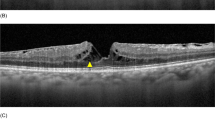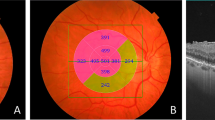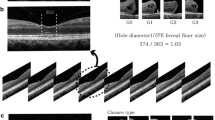Abstract
Purpose
To compare the foveal characteristics in fellow eyes (FE) of patients with unilateral idiopathic macular hole without vitreomacular pathologic changes with eyes of healthy controls.
Methods
Forty-seven FE and 52 eyes of 52 age- and sex-matched healthy controls were studied. Quantitative assessment of the dome-shaped appearance of the hyperreflective lines that represent external limiting membrane (ELM_bulge) and inner outer segment junctions (IS/OS_bulge) were made by optical coherence tomography (OCT) images. Inner retinal complex thickness (IRCT) was quantitatively assessed at 1000 and 2000 μm of the foveal center in nasal and temporal quadrants. Presence of alterations in the inner retinal outer layers and central foveal thickness (CFT) were also analyzed.
Results
Significantly lower ELM_bulge (p < 0.0001; Mann-Whitney test) and IS/OS_bulge (p < 0.001; student t test) and higher cases with COST alterations, expressed as a diffuse line (p < 0.006; Chi2 test) were found in FE than control eyes. IRCT were significantly reduced in FE at all the studied locations when comparing to control eyes (p < 0.05; student t test), maintaining anatomical proportionality among locations.
Conclusion
FE without pathologic vitreomacular interactions seems to present some central cone alterations that may be related to other causes than vitreomacular traction.


Similar content being viewed by others
References
Yuodelis C, Hendrickson A (1986) A qualitative and quantitative analysis of the human fovea during development. Vis Res 26(6):847–855
Hendrickson A, Possin D, Vajzovic L, Toth CA (2012) Histologic development of the human fovea from midgestation to maturity. Am J Ophthalmol 154(5):767–778
Hasegawa T, Ueda T, Okamoto M, Ogata N (2014) Presence of foveal bulge in optical coherence tomographic images in eyes with macular edema associated with branch retinal vein occlusion. Am J Ophthalmol 157(2):390–396.e1
Thomas MG, Kumar A, Mohammad S et al (2011) Structural grading of foveal hypoplasia using spectral-domain optical coherence tomography a predictor of visual acuity? Ophthalmology 118(8):1653–1660
Mohammad S, Gottlob I, Kumar A et al (2011) The functional significance of foveal abnormalities in albinism measured using spectral-domain optical coherence tomography. Ophthalmology 118(8):1645–1652
Scholl HP, Birch DG, Iwata T et al (2012) Characterizing the phenotype and genotype of a family with occult macular dystrophy. Arch Ophthalmol 130(12):1554–1559
Al-Haddad CE, El Mollayess GM, Mahfoud ZR et al (2013) Macular ultrastructural features in amblyopia using high-definition optical coherence tomography. Br J Ophthalmol 97(3):318–322
Hashimoto Y, Saito W, Saito M et al (2014) Retinal outer layer thickness increases after vitrectomy for epiretinal membrane, and visual improvement positively correlates with photoreceptor outer segment length. Graefes Arch Clin Exp Ophthalmol 252(2):219–226
Ichiyama Y, Kawamura H, Fujikawa M et al (2016) Photoreceptor outer segment length and outer foveal thickness as factors associated with visual outcome after vitrectomy for vitreomacular traction syndrome. Retina 36(9):1707–1712
Ho AC, Guyer DR, Fine SL (1998) Macular hole. Surv Ophthalmol 42:393–416
Olsen TW, Adelman RA, Flaxel CJ, Folk JC, et al (2014). American Academy of ophthalmology retina/vitreous panel. Preferred Practice Pattern® Guidelines. Idiopathic Macular Hole. San Francisco, CA. https://www.aao.org/preferred-practice-pattern/idiopathic-macular-hole-ppp—2014. Accessed 12 July 2016
Ezra E, Wells JA, Gray RH et al (1998) Incidence of idiopathic full-thickness macular holes in fellow eyes. A 5-year prospective natural history study. Ophthalmology 105:353–359
Freeman WR, Azen SP, Kim JW et al (1997) Vitrectomy for the treatment of full-thickness stage 3 or 4 macular holes. Results of a multicentered randomized clinical trial. The Vitrectomy for treatment of macular hole study group. Arch Ophthalmol 115(1):11–21
Kim JW, Freeman WR, Azen SP et al (1996) Vitrectomy for macular hole study group. Prospective randomized trial of vitrectomy or observation for stage 2 macular holes. Am J Ophthalmol 121:605–614
Gass J (1995) Reappraisal of biomicroscopic classification of stages of development of a macular hole. Am J Ophthalmol 119:752–759
Aras C, Ocakoglu O, Akova N (2004) Foveolar choroidal blood flow in idiopathic macular hole. Int Ophthalmol 25:225–231
Gass JD (1988) Idiopathic senile macular hole: its early stages and pathogenesis. Arch Ophthalmol 106:629–639
Duker JS, Kaiser PK, Binder S et al (2013) The international Vitreomacular traction study group classification of vitreomacular adhesion, traction, and macular hole. Ophthalmology 120(12):2611–2619
Sharanjeet-Kaur, O’Donaghue E, Murray IJ (2003) Spectral sensitivity in eyes with macular holes and their fellow eyes. Clin Exp Optom 86(6):385–389
Birch DG, Jost BF, Fish GE (1988) The focal electroretinogram in fellow eyes of patients with idiopathic macular holes. Arch Ophthalmol 106(11):1558–1563
Gass JD (1999) Müller cell cone, an overlooked part of the anatomy of the fovea centralis: hypotheses concerning its role in the pathogenesis of macular hole and foveomacualr retinoschisis. Arch Ophthalmol 117(6):821–823
Yamada E (1969) Some structural features of the fovea centralis in the human retina. Arch Ophthalmol 82:151–159
Takahashi A, Nagaoka T, Yoshida A (2011) Stage 1-a macular hole: a prospective spectral-domain optical coherence tomography study. Retina 31(1):127–147
Uemura A, Otsuji F, Nakano T, Sakamoto T (2014) Vitreomacular interface and outer foveal microstructure in fellow eyes of patients with unilateral macular holes. Retina 34(6):1229–1234
Chan A, Duker JS, Schuman JS, Fujimoto JG (2004) Stage 0 macular holes: observations by optical coherence tomography. Ophthalmology 111(11):2027–2032
Zeng J, Li J, Liu R et al (2012) Choroidal thickness in both eyes of patients with unilateral idiopathic macular hole. Ophthalmology 119(11):2328–2333
Reibaldi M, Boscia F, Avitabile T, et al. (2011) Enhanced depth imaging optical coherence tomography of the choroid in idiopathic macular hole: a cross-sectional prospective study. Am J Ophthalmol; 151(1):112-117.e2
Morgan CM, Schatz H (1985) Idiopathic macular holes. Am J Ophthalmol 99(4):437–444
Morgan CM, Schatz H (1986) Involutional macular thinning. A pre-macular hole condition. Ophthalmology 93(2):153–161
Haugh LM, Linsenmeier RA, Goldstick TK (1990) Mathematical models of the spatial distribution of retinal oxygen tension and consumption, including changes upon illumination. Ann Biomed Eng 18(1):19–36
Yu DY, Cringle SJ (2001) Oxygen distribution and consumption within the retina in vascularised and avascular retinas and in animal models of retinal disease. Prog Retin Eye Res 20(2):175–208
Barrong SD, Chaitin MH, Fliesler SJ et al (1992) Ultrastructure of connecting cilia in different forms of retinitis pigmentosa. Arch Ophthalmol 110(5):706–710
Berson EL, Adamian M (1992) Ultrastructural findings in an autopsy eye from a patient with Usher’s syndrome type II. Am J Ophthalmol 114(6):748–757
Milam AH, Li ZY, Cideciyan AV, Jacobson SG (1996) Clinicopathologic effects of the Q64ter rhodopsin mutation in retinitis pigmentosa. Invest Ophthalmol Vis Sci 37(5):753–765
Ooka E, Mitamura Y, Baba T et al (2011) Foveal microstructure on spectral-domain optical coherence tomographic images and visual function after macular hole surgery. Am J Ophthalmol 152(2):283–290.e1
Itoh Y, Inoue M, Rii T, Hiraoka T, Hirakata A (2012) Correlation between length of foveal cone outer segment tips line defect and visual acuity after macular hole closure. Ophthalmology 119(7):1438–1446
Itoh Y, Inoue M, Rii T, Hiraoka T, Hirakata A (2012) Significant correlation between visual acuity and recovery of foveal cone microstructures after macular hole surgery. Am J Ophthalmol 153(1):111–9.e1
Jones BW, Pfeiffer RL, Ferrell WD et al (2016) Retinal remodeling in human retinitis pigmentosa. Exp Eye Res 150:149–165
Marc RE, Jones BW, Watt CB, Stretoii E (2003) Neural remodeling in retinal degeneration. Prog Retin Eye Res 22:607–655
Author information
Authors and Affiliations
Corresponding author
Ethics declarations
Funding
No funding was received for this research.
Conflict of interest
All authors certify that they have no affiliations with or involvement in any organization or entity with any financial interest (such as honoraria; educational grants; participation in speakers’ bureaus; membership, employment, consultancies, stock ownership, or other equity interest; and expert testimony or patent-licensing arrangements), or non-financial interest (such as personal or professional relationships, affiliations, knowledge or beliefs) in the subject matter or materials discussed in this manuscript.
Ethical approval
All procedures performed in studies involving human participants were in accordance with the ethical standards of the institutional and/or national research committee and with the 1964 Helsinki declaration and its later amendments or comparable ethical standards.
Informal consent
For this type of study formal consent is not required.
Rights and permissions
About this article
Cite this article
Delas, B., Julio, G., Fernández-Vega, Á. et al. Reduction of foveal bulges and other anatomical changes in fellow eyes of patients with unilateral idiopathic macular hole without vitreomacular pathologic changes. Graefes Arch Clin Exp Ophthalmol 255, 2141–2146 (2017). https://doi.org/10.1007/s00417-017-3765-z
Received:
Revised:
Accepted:
Published:
Issue Date:
DOI: https://doi.org/10.1007/s00417-017-3765-z




